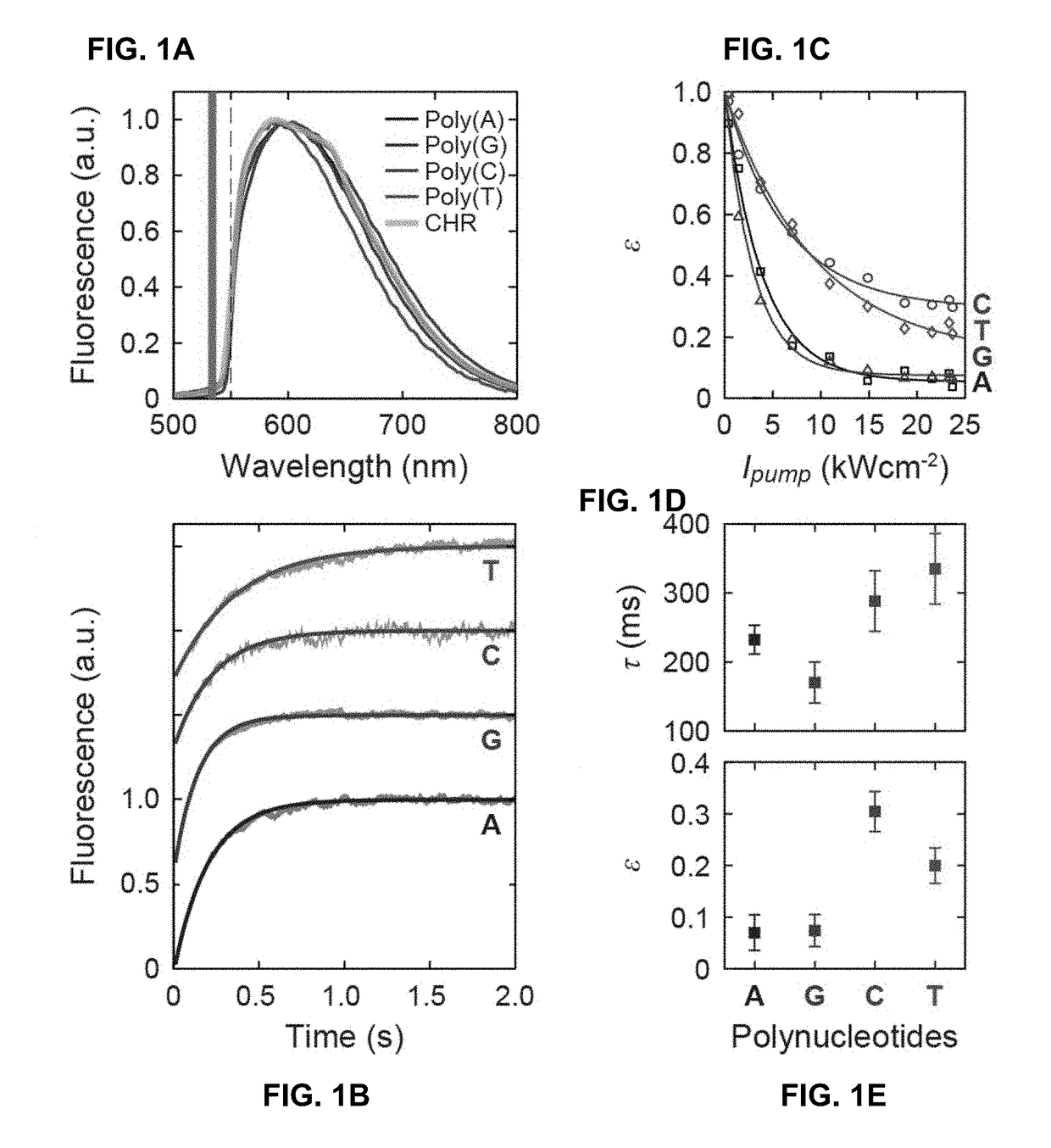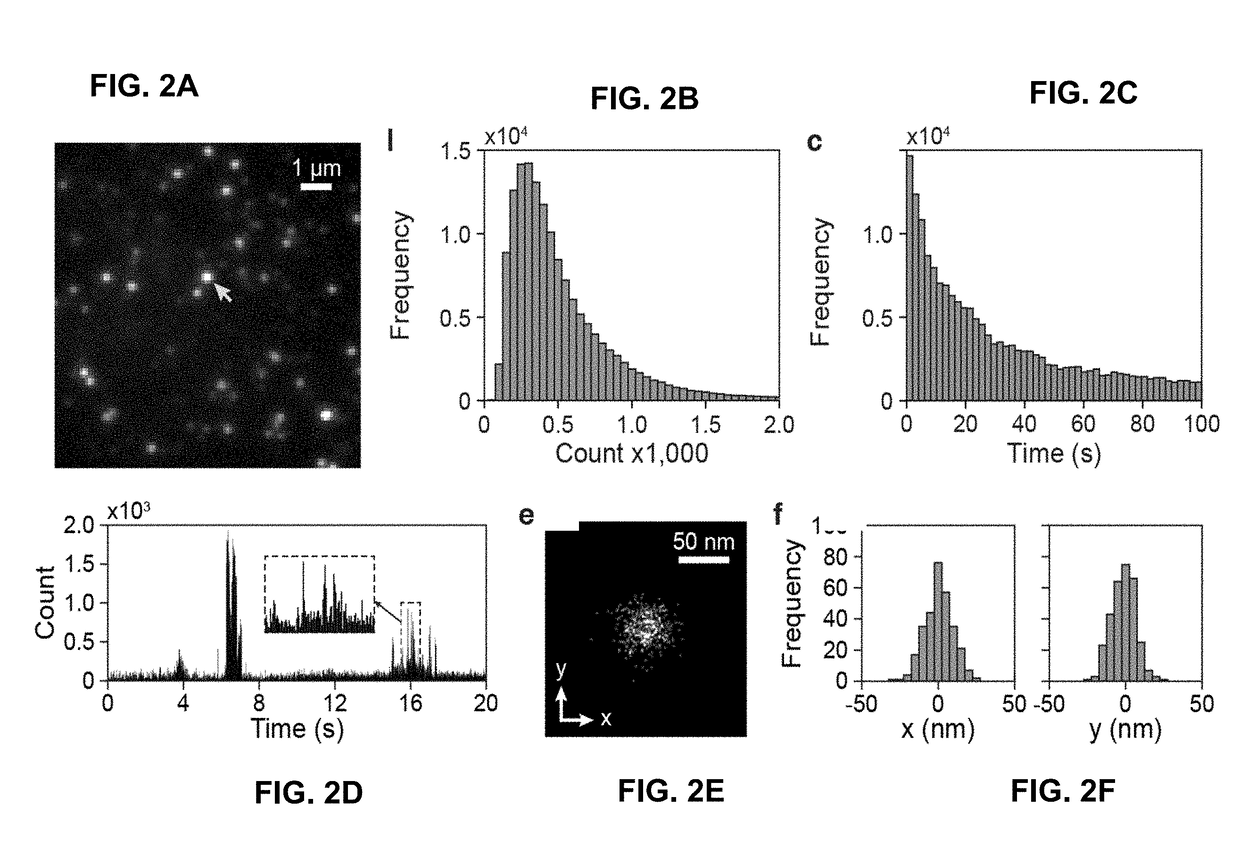Devices, methods, and systems relating to super resolution imaging
- Summary
- Abstract
- Description
- Claims
- Application Information
AI Technical Summary
Benefits of technology
Problems solved by technology
Method used
Image
Examples
example 1
[0097]Certain examples determine stochastic fluorescence switching in nucleic acids under visible light illumination. By combining the principle of photon-localization microscopy, certain examples provide optical super-resolution imaging of native, unmodified DNA molecules; a technique referenced herein as DNA-PLM. Super-resolution imaging is then conducted from isolated, unstained chromosomes and nuclei, revealing nanoscopic features of chromatin without the need for exogenous labels. This paves the way for unperturbed, label-free nanoscale imaging of chromatin structure.
[0098]Results
[0099]In our study, we first used short single-stranded polynucleotides (e.g., 20-bp poly-A, G, C, and T, IDT) as model systems to investigate the fluorescence excitation and photo-switching of DNA molecules. Although nucleic acids have significantly weaker absorption for visible versus UV light, they exhibit low, but detectable, absorption due to the electron delocalization effect, in part arising fro...
example 2
[0119]Nucleic acids have significantly weaker absorption for visible versus UV light. However, they exhibit low, but detectable, absorption in the visible range due to the electron delocalization arising from the aromatic rings. This is a fundamental property critical to their molecular function and stability. Visible light absorption by nucleic acids have been measured and the data are readily available. The molar extinction of nucleotides in the visible is E˜50 cm−1 M−1, which is 260 times lower than their UV absorption and >1,000 times lower than the peak absorption of strong extrinsic fluorophores, such as rhodamine. We recorded fluorescence from mononucleotides, nucleic acid bases, and short single-stranded polynucleotides (e.g., 20-bp poly-A, G, C, and T, IDT). This radiative process was consistent with endogenous fluorescence; the emission excited at 532 nm by a pulsed laser had a lifetime τfl˜2 ns, which is typical of fluorescence lifetimes of high-Q fluorophores.
[0120]Integ...
example 3
[0125]In Raman scattering and fluorescence excitation and emission, incident photons interact with the intrinsic electronic or vibrational states of the sample and subsequently emit frequency-shifted photons due to the underlying energy exchange. Analyzing the spectroscopic signatures obtained from inelastic light scattering measurements is a widely used method for revealing the electronic and structural properties for natural and engineered materials in subjects ranging from biology to materials science. Additionally, a variety of spectroscopic imaging techniques have been developed to probe the heterogeneous environment within samples, yet their spatial resolutions have been limited to about half of the wavelength due to light diffraction. Although near-field scanning optical microscopy (NSOM) offers nanometer-scale spatial resolution by using a sharp stylus for scanning at the close vicinity of the sample surface, it is unable to image sub-surface features because rapidly decayin...
PUM
| Property | Measurement | Unit |
|---|---|---|
| Intrinsic viscosity | aaaaa | aaaaa |
| Fluorescence | aaaaa | aaaaa |
Abstract
Description
Claims
Application Information
 Login to View More
Login to View More - R&D
- Intellectual Property
- Life Sciences
- Materials
- Tech Scout
- Unparalleled Data Quality
- Higher Quality Content
- 60% Fewer Hallucinations
Browse by: Latest US Patents, China's latest patents, Technical Efficacy Thesaurus, Application Domain, Technology Topic, Popular Technical Reports.
© 2025 PatSnap. All rights reserved.Legal|Privacy policy|Modern Slavery Act Transparency Statement|Sitemap|About US| Contact US: help@patsnap.com



